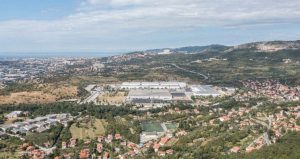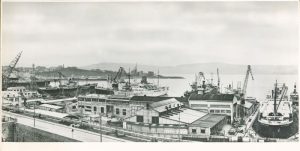Summary:
• Introduction
• The Shareholders Behind Interporto di Trieste S.p.A.
• What Is a “Free Zone” Under the Peace Treaty
• The Old Port: International Asset, Public Function
• The FREEeste Operation: Relocating the Free Zone
• British American Tobacco: Not a Guest, but the Boss
• The MSC Case and Operational Opacity
• From Imperial City to Second-Hand Depot
• The Mindless Euphoria of the Democratic Party
• US–UK Administration in Trieste (1947–1954)
• Conclusion: A Free Zone for Those Holding the Keys
1. Introduction
In recent years, public debate over the transformation of Trieste’s Old Port has taken a misleading turn. Buzzwords like “redevelopment” and “logistics innovation” are being used to cover up a much more serious operation: the dismantling of a historic, international, and collective public function.
The relocation of the free customs zone from the historic port area to a private inland industrial zone managed by Interporto S.p.A. marked a radical break with the past. The name “FREEeste” is nothing more than a glossy marketing package for a process of economic, legal, and symbolic privatization.
2. The Shareholders Behind Interporto di Trieste S.p.A.
FREEeste is an inland industrial zone exclusively owned by an Italian joint-stock company: Interporto di Trieste S.p.A.
Here is the updated list of shareholders:
• Friulia S.p.A. (Regional finance company of Friuli Venezia Giulia): 31.99%
• Port Authority of the Eastern Adriatic Sea: 20%
• Chamber of Commerce Venezia Giulia: 16.54%
• Municipality of Trieste: 11.05%
• Municipality of Monrupino: 5.52%
• Duisport (German public port): 15%
• Municipality of Gorizia: 1% – symbolic share
Interporto di Trieste S.p.A.: the corporate structure behind FREEeste.
Formally a public entity, operationally opaque.
This is where the “free zone” of Trieste’s Old Port—an international public asset belonging to the Free Territory of Trieste—was transferred, without any international legal authority.
While the majority of shares are technically public, in practice access to the area is managed internally and governed by private corporate logic, which has little or nothing to do with a free port as envisioned by international law.
3. What Is a “Free Zone” Under the Peace Treaty
The Treaty of Peace with Italy – annex VIII, signed on February 10, 1947, established five “free zones” within the port of Trieste. These areas were granted an extra-customs regime and were placed under international jurisdiction.
Access to these zones had to be open and guaranteed, serving the interests of international trade and the citizens of the Free Territory of Trieste, as explicitly set out in Annex VIII of the Treaty.
These were not ordinary special economic zones. They were designed as tools of commercial neutrality, rooted in public international law.
4. The Old Port: International Asset, Public Function
The Old Port of Trieste, the city’s historic economic heart, was one of the most important free zones.
Its importance was not only commercial, but deeply symbolic: it embodied the international regime of the Free Territory.
Its removal from state assets—what Italian authorities call “sdemanializzazione”—marked the beginning of the dismantling of public sovereignty over that space.
5. The FREEeste Operation: Relocating the Free Zone

FREEeste: the inland simulacrum of the international free port. No docks, no international legality, no transparency. Reserved for a select circle of multinationals.
In 2019, the industrial free zone was officially moved from the Old Port to the Bagnoli della Rosandra area—within the privately owned FREEeste, controlled by Interporto S.p.A.
While the customs regime was technically transferred, its public nature was not.
The result is a de facto privatized extra-customs zone, accessible only to major industrial players.
6. British American Tobacco: Not a Guest, but the Boss
BAT—British American Tobacco—is the first, and still the only, major player operating within FREEeste.
A powerful UK-based tobacco conglomerate, BAT also acquired the former Italian State Monopoly for tobacco.
It didn’t arrive as a guest—it came on its own terms: one of the prerequisites for its investment was the designation of the area as an industrial free zone.
No local business could have negotiated such conditions.
It is no coincidence that the key players here are the US and the UK—the very powers that administered the Free Territory of Trieste from 1947 to 1954.
Two years after the inauguration of BAT’s Innovation Hub in Trieste, the numbers speak for themselves:
-
Investments doubled in 2024 (up to €168 million),
-
Production increased,
-
Profits reinvested locally,
-
Workforce grew from 114 to over 290 employees.
With a growing local supply chain, BAT remains the only truly operational actor within the “free zone” of FREEeste—and it does so from a dominant position.
7. The MSC Case and Operational Opacity
MSC has also announced plans to build a rail wagon manufacturing facility within FREEeste.
However, to date, there is no reliable data confirming the start of production, nor any public verification regarding the application of the extra-customs regime.
No transparency. No declared public oversight.
Everything happens below the threshold of civic visibility.
Only on July 2, 2025, the first freight wagon rolled out from the production line of Innoway Trieste, a joint venture between Innofreight and MSC, which had taken over the former Wärtsilä plant.
A symbolic milestone—but a far cry from the past:
that facility once employed over a thousand workers. Today, operations began with barely 50.
In theory, it is set to become Europe’s most advanced railcar plant by 2027.
In practice, for now, it’s little more than a construction site.
8. From Imperial City to Second-Hand Depot

The Old Port of Trieste: material evidence of international sovereignty over the city. Seven hectares of trade and infrastructure under an extra-customs regime, protected by international law. Erased without legal title by the Italian State and replaced with an inland caricature.
FREEeste is not the Old Port. It isn’t even a caricature of it.
It is something radically different—and infinitely poorer.
The Old Port was the economic projection of Trieste’s imperial city status—a Reichsunmittelbare Stadt directly connected to the world via sea, with seven hectares of bustling international traffic. The port was placed there for a reason: because the Canal Grande area was overflowing with activity.
FREEeste, by comparison, is a landlocked industrial backlot.
It hosts a single Anglo-American multinational, and maybe, someday, a railway factory.
It is the negation of Trieste’s historic port function.
Or, as Fantozzi might have said: “una cagata pazzesca.”
(“A total piece of crap.”)
9. The Mindless Euphoria of the Democratic Party
In 2014, during the illegal removal of the Old Port from public domain (sdemanializzazione), Trieste witnessed one of the most grotesque chapters in its political history: a drunken celebration of rhetoric and self-congratulation from local and national leaders of the Democratic Party (PD).
-
Debora Serracchiani called it a “historic turning point” and “a unique customs system in Europe.”
-
Even Mayor Roberto Dipiazza—from the center-right, not the PD—joined the chorus of self-congratulation: “It was emotional.”
-
Francesco Russo, the man behind the legal handover, declared they had “changed the future of Trieste’s port.”
-
Ettore Rosato spoke of a “revolution,” and Antonella Grim praised it as the PD’s “irreplaceable success.”
-
Even the Five Star Movement (M5S) jumped on board, albeit late and clueless.
But no one explained a simple legal truth:
The Old Port was public property, meaning state-owned—but not by the Italian State.
It belonged to the Free Territory of Trieste, and was protected under the 1947 Peace Treaty.
What did Italian administrators do instead?
They erased a public asset belonging to another State, without any legal title, while pretending to “relocate” its customs function to a privately controlled zone.
A real heist, masked as modernization.
This was sold to the public as “vision,” “revival,” and “opportunity.”
In reality, it was the obedient execution of a broader economic looting plan, aimed at:
-
erasing all physical evidence of the Free Territory’s sovereignty,
-
making annexation irreversible, and
-
striking at the heart of the historical and political memory of what they saw as “the separatist Stalingrad.”
Forget logistics: this was a legal and symbolic Ground Zero, carefully engineered to destroy the visible foundations of international law in the port of Trieste.
Zeno D’Agostino in 2019: the future that was promised
“A new inland logistics hub projecting Trieste into the future of European trade.”
He presented FREEeste as the natural evolution of the Free Port.
“We transferred the function and benefits of the free zone to this area […] fully equipped with infrastructure.”
Words that imply a simple move—but hide the fact that the area is private and far from the sea.
“This isn’t an isolated terminal: it’s an integrated hub capable of attracting major investment.”
The rhetoric of modernization, packaged for multinational appetites.
Six years later, those words sound like a crafted narrative, designed to cover up a profound, irreversible transformation:
From international free port to privatized customs zone.
D’Agostino failed to mention:
-
the illegal removal of the Old Port from the international public domain;
-
the privately governed nature of the new site;
-
and the impact on public commercial sovereignty.
FREEeste was never a port. It is infrastructure for the few.
And the grand 2019 celebration now reads exactly for what it was:
Inauguration speech on the surface, funeral march for international law underneath.
10. US–UK Administration in Trieste (1947–1954)
From 1947 to 1954, the Free Territory of Trieste was placed under the provisional military administration of the United States and the United Kingdom.
This administration was never formally revoked.
Today, those very same powers return—not (only) with weapons, but with brands.
The privileged access granted to British American Tobacco, and the deafening political silence surrounding it, are not isolated facts.
They are part of a broader pattern: a continuity of external control, now dressed in the clothes of logistics, multinationals, and corporate influence.
Power never left. It just changed uniform.
11. Conclusion: A Free Zone for Those Holding the Keys
The free port was meant to be a tool for commercial freedom—for Trieste and for the world.
FREEeste is a customs zone tailor-made for multinationals.
Local and regional institutions, rather than defending the international vocation of the port, have actively supported the privatization of one of the most powerful instruments of civil and commercial sovereignty belonging to the Free Territory of Trieste.
They did it quietly.
Without public hearings.
Without public debate.
There is nothing “free” left in FREEeste—except the name.
– Alessandro Gombač –

 newsletter
newsletter
 contact us
contact us
 donations
donations